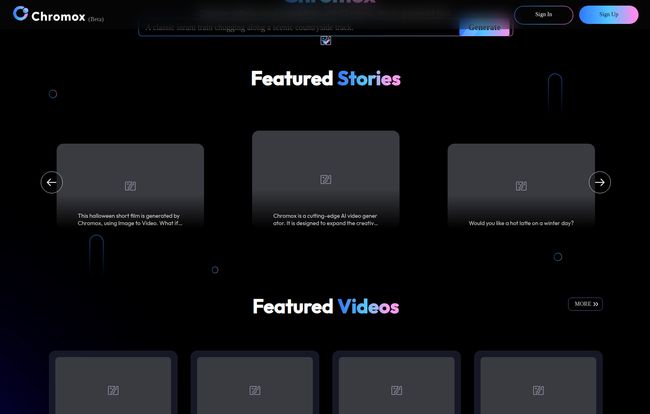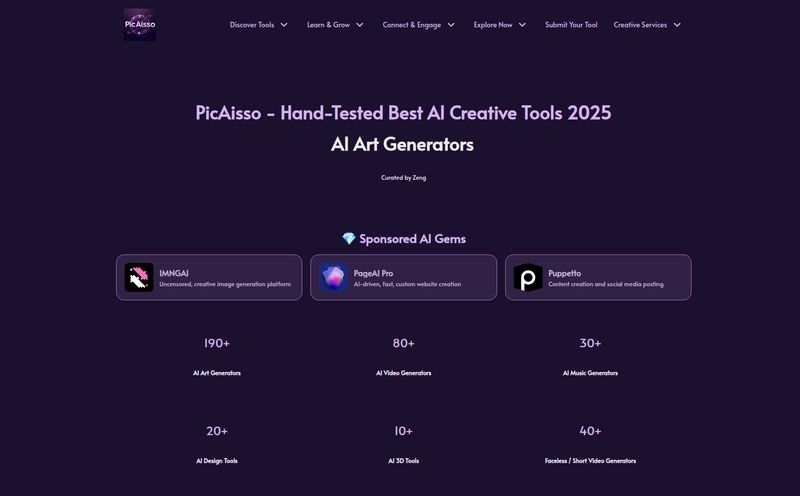Another day, another AI tool lands on my desk. Seriously, it feels like we’re in the middle of a digital gold rush, and every developer with a clever algorithm is staking their claim. Most of it is noise. But every now and then, something pops up that makes you lean in a little closer to your screen. Today, that something is called Chromox.
I’ve been in the SEO and traffic game for years, and I’ve seen trends come and go. Video is not a trend; it's the main event. The problem? Making good video is hard. It takes time, skill, and often, a hefty budget. So when a tool promises to simplify all that with a few lines of text, my professional skepticism kicks in. But so does my curiosity.
So, What is Chromox, Really?
Let's get past the marketing jargon. Chromox is an AI video generator. In plain English, you give it a prompt—either a sentence describing a scene or a still image—and it spits out a short video clip. It’s part of that new wave of generative AI, think Midjourney but for moving pictures. The whole idea is to take the friction out of video creation.
You no longer need a camera crew or complex animation software to visualize an idea. You just need the idea itself. Want to see “a blue hologram of the globe surrounded by hi tech elements”? Just type it in. I saw that exact prompt on their site. Or how about “Spiderman plays the guitar”? Yep, that too. This is where these tools start getting really interesting, blurring the lines between absurdity and artistry.
The Magic Behind the Curtain: Its Core Features
Chromox isn't just a one-trick pony. It’s built on a couple of core functions that are quickly becoming the industry standard for AI video tools.
From Words to Motion Pictures
The main attraction is its text-to-video capability. This is the bread and butter. You type a descriptive prompt, like the example on their homepage: “A classic steam train chugging along a scenic country track.” The AI then interprets your words and generates a video to match. The quality of the output, of course, depends on the AI's training and the clarity of your prompt. Prompt engineering is a skill in itself, something we've all been learning since the first AI image generators hit the scene.
Breathing Life into Still Images
This one really caught my eye. Chromox also has an Image-to-Video feature. You can upload a static image and the AI will add motion to it, turning a photograph or a piece of digital art into a living scene. This is huge for artists, marketers, and social media managers. Imagine animating your company logo, a product shot, or a piece of concept art with just a click. It's a powerful way to repurpose existing assets and create eye-catching content without a motion graphics designer on standby.
My First Impressions of the Platform
Hopping onto the Chromox site, the first thing I noticed was the clean, dark-mode interface. It feels modern and creator-focused. Right away, you’re greeted with “Featured Stories” and “Featured Videos,” which is a smart move. It’s a living portfolio that shows you exactly what the tool is capable of, powered by its own user community.
Scrolling through the featured videos is a trip. I saw prompts for that Spiderman playing a guitar, a hyperrealistic Jim Carrey Grinch, and a confused duck. Yes, a confused duck. This gallery isn't just for show; it’s a source of inspiration. Each video has the original prompt listed right there, along with a “Generate” button. It’s an open invitation to riff on other people’s ideas, which is how creative communities thrive. It lowers the barrier to entry—you don’t even need an original idea to get started.

Visit Chromox
Who is This Actually For?
I can see a few groups getting a lot of milage out of a tool like Chromox.
- Content Creators & Social Media Managers: This is a no-brainer. Need a quick, unique video for TikTok, Reels, or Shorts? Done. It's perfect for generating B-roll footage, creating abstract backgrounds, or just making content that stops the scroll.
- Marketers & Advertisers: For storyboarding concepts or creating lightweight video ads for CPC campaigns, this could be a game-changer. It's a way to test visual ideas rapidly without committing to a full-scale production.
- Artists & Designers: The image-to-video feature is a massive playground. Animating a painting, a character design, or a digital sculpture could add a whole new dimension to their work.
- Indie Filmmakers & Writers: Visualizing a scene from a script or pre-visualizing a shot before you even scout a location? Tools like this make that process incredibly accessible.
The Million-Dollar Question: What's the Price Tag?
Alright, let's talk about the cost. As of right now, the website is a bit shy about pricing. The platform is currently in beta, which usually means one of two things: it’s either free for early users to test and provide feedback, or they just haven’t finalized their pricing structure yet. My money's on a bit of both.
If Chromox follows the path of its competitors like Runway or Pika Labs, we can probably expect a freemium model. This would likely involve a certain number of free credits to generate videos each month, with paid subscription tiers for more credits, faster processing, higher resolutions, and removing watermarks. For now, it seems like a good time to jump in and play around while it's potentially free of charge.
The Good and the Potential Hurdles
No tool is perfect, especially in a field that's evolving as quickly as AI video. From what I’ve seen, the advantages are pretty clear: it simplifies a complex process, it opens up creative avenues for non-video experts, and it can handle both text and image inputs. That’s a strong foundation.
On the flip side, we have to be realistic. Some might argue that these tools are still in their infancy. You might encounter some of that classic AI weirdness—a hand with six fingers, objects morphing unnaturally, or motion that doesn't quite obey the laws of physics. There's also the question of processing time and the eventual cost. But honestly, these are the growing pains of any groundbreaking technology. The fact that we can even do this in a browser window is pretty mind-blowing if you ask me.
So, Is Chromox Worth Your Time?
In my opinion, absolutely. Even if you just sign up to play around, it’s worth seeing what the current state of AI video looks like. Tools like Chromox are more than just novelties; they represent a fundamental shift in how we’ll create and consume visual media. We’re moving from being passive consumers to active creators, and the only barrier is the limit of our own imagination.
The platform feels polished for a beta, and the community-driven gallery is a fantastic touch. It's not trying to be OpenAI's Sora, which is still behind a very exclusive curtain. Instead, Chromox feels accessible and ready for people to start creating now. It’s a practical tool for the creative chaos of today, not a far-off promise for tomorrow.
Frequently Asked Questions
- 1. What is Chromox?
- Chromox is a web-based AI tool that generates short video clips from text descriptions (text-to-video) or still images (image-to-video). It's designed for creators, marketers, and anyone looking to produce video content easily.
- 2. Is Chromox free to use?
- Currently, Chromox is in a beta phase, and pricing information isn't publicly listed. Often, tools in beta are free for early adopters to use and test, but a subscription model will likely be introduced later.
- 3. What kind of videos can I create?
- You can create a huge variety of videos, from realistic scenes like a train on a track to completely imaginative concepts like superheroes playing instruments or futuristic cityscapes. The output quality depends on the clarity of your prompts.
- 4. Do I need any special skills to use Chromox?
- Not at all. If you can write a sentence or upload a picture, you have all the skills you need. The user interface is straightforward and encourages experimentation.
- 5. How does Chromox compare to other AI video tools?
- Chromox fits into the same category as tools like Pika Labs and RunwayML, offering both text-to-video and image-to-video functionalities. Its main strengths appear to be its user-friendly interface and community-focused approach to showcasing generated content.
Conclusion
Look, the AI space is crowded, and it's only going to get more so. But Chromox has made a strong first impression. It’s not just about the technology; it’s about the accessibility. It’s about giving a powerful creative tool to anyone with an internet connection. I’m genuinely excited to see how it develops after this beta phase and what people create with it. For now, I’m off to see if I can make a video of a cat conducting an orchestra. Why not, right?



